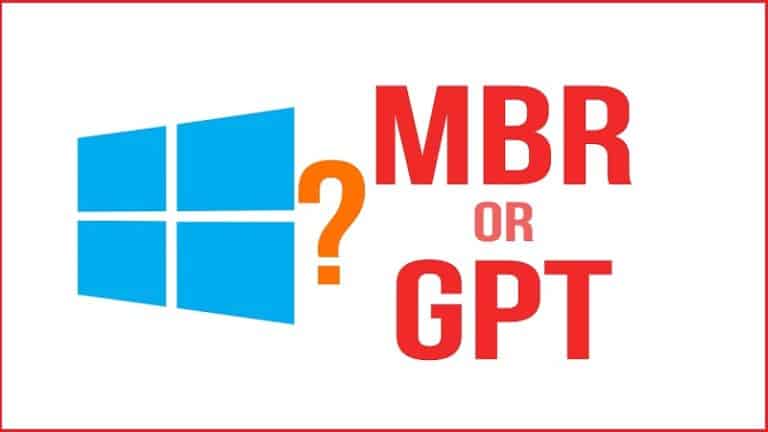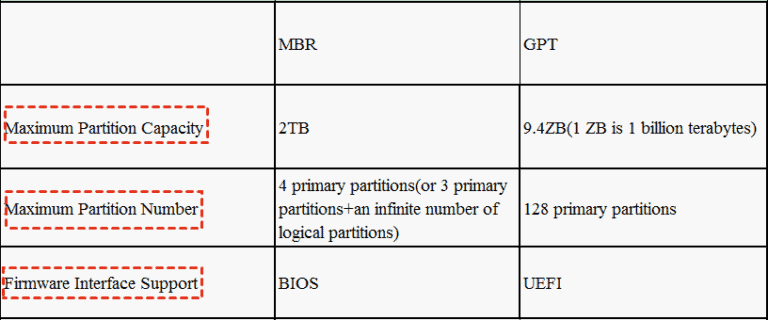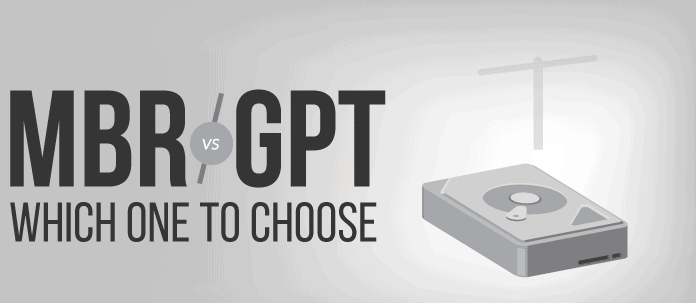Introducing GPT Vs. MBR: Which is Better for your Hard Drive?
The GPT and MBR are two hardware partition techniques. The GPT maintains the new standard. For offering each option, it boots the structure. Which way the data is handled is unique. The GPT Vs MBR speed varies between the two partition options. The requirements are different. The article also explains, what they actually are, what they require and how they differ from each other.
What's a partition? GPT Vs MBR
You just need to understand what is MBR and GPT partition. Partitions are separate sections on a hard drive the operating system uses to boot and proper functioning.
The Window displays the partition in the drive in the file explorer, though they are on the hard disk drive.
For example, there are a large number of system partitions, the drives in the Window operating drive. If you select C drive, it also has a hidden recovery partition. How to restore the system in the case of a mishap? Another reason is to use multiple operating systems on the same hard disk drive, such as on Windows 7, GPT Vs. MBR Windows 10, and Linux.
GPT Vs MBR: Which is better for your hard drive?

The structure of the partition defines, which information is structured on the partition, and where the partition of the disk starts and ends. There is also a code that is used during the start-ups if the partition is bootable.
What is MBR?

MBR is called master boot record. It describes how the partition is created and organized on the hard disk drive. MBR uses the Bios frameworks. It restores the code in the first sector of the disk. It has a “logical block address”.
The data also includes information on how and where the Window resides. It will help to manage the boot process in the PC’s primary storage. It has internal random access memory (RAM). The external memory consists of the DDR2 and DDR3 memory cards and sticks.
The MBR data is stored in LBA: The HDD comes with the following features:
MPT:
The master partition table stores all the partitions; that information is found on each HDD. It includes all the format types, capacity, and other necessary details. In this way, the OS and PC function in a proper way correctly.
They also have a record of HDD partitions and are available in different sizes. But you need to identify the active partition and bootable. The MPT provides all the important information.
Disk Signature:
Every drive requires a unique identifier; it is created in the form of a signature. The identifier also ensures the correct drive. The partition reads and writes the data while using several disks. Make it ensure the proper PC functionality and the security protocol read and write data transactions.
Master Boot Code:
MBC code is executing on the launch of the operating system. It helps to manage the configuration for the boot-up process. It also confirms any changes, such as detecting the drives, making calculations in RAM (making calculations in RAM, detecting the display and other essential devices and providing the configuration information.
The Computer motherboard has the basic input/output operating system. The Bios look for the device with an MBR. It performs the volume boot code from all partitions it has. Furthermore, MBR also activates the boot sector of the drive and launches the Operating system.
What is a GPT Partition?

GPT is the abbreviation of the GUID partition table. It also manages the creation and organization partition on the Hard disk Drive. GPT also uses the UEFI firmware. It deposits all the information. It may also include the partition sizes and the other essential data. Just as MBR does in sector one.
GPT uses the two sectors. Sector one is reserved for MBR and supports the Bios compatibility. The GPT, in technical terms, is called MBR sector #1 (LBA 1) is actually LBA 0 for GPT, and GPT is sector 1 (LBA 1).
The data is stored in the GPT header. It also includes drive information in the GUID partition table. The GUID table also includes all details on drives, storage sizes, and drive partition and provides the boot information. The essential data is related to boot and functionality. The GUID partition data is stored in the LBA 1, which may also include the HDD (hard disk drives).
The partition is described in the following ways:
- GPT Data
- MBR Data
- Enter the partition data
- Secondary GPT Data.
GPT's Advantages
GPT is the abbreviation of the GUID partition. It is gradually set the new standard and gradually sets the MBR. It is also associated with the UEFI, which helps to replace the bios with the modern ones.
In return, GPT replaces the old MBR partition system. It is called the GUID partition on every partition. The drive has a globally unique identifier. The Guid is a random string. The partition of GPT has its own identifier.
GPT does not have any issue with MBR limits. The GPT-based drives are large in size. The size limit is based on the operating system and file system.
GPT also allows you an unlimited limit of partitions. The limit will be your operating system. The Window also allows you to GPT drive up to the 128 partitions. You don’t need to create an extended partition to set it to work.
Differences between GPT and MBR partitions:

There are a number of differences between MBR and GPT partitions, but we’ll cover some of the main bones then.
MBR partition tables have a maximum capacity of only about two terabytes. You can use a drive that is larger than two terabytes with MBR, but only the first two terabytes of the drive will be used. The rest of the storehouse on the drive will be wasted.
In discrepancy, GPT partition tables offer a maximum capacity of9.4 zettabytes. One zettabyte is about 1 billion terabytes, so you are doubtful that it will run out of space anytime soon.
MBR partition tables can also have up to four different partitions on the outside. Even yet, one of those partitions can be set up as an extended partition, which is a partition that can be split into 23 new partitions. As a result, the absolute maximum number of partitions in an MBR partition table is 26.
GPT partition tables allow for over 128 separate partitions, which is further than enough for the utmost real-world operations.
As MBR is older, it has always paired with older inheritance BIOS systems, whereas GPT is found on newer UEFI systems. This implies that MBR partitions have higher computer code and hardware compatibility, tho’ GPT is beginning to catch up.
GPT Vs MBR. Which one to choose?

If you want to get an external GPT Vs MBR SSD or HDD, you will have to choose between MBR or GPT partition. You can also format the drive with GPT if you want to take advantage of the fast speed and significant large storage capacities and enjoy unlimited partition.
There are some reasons to use MBR. If you want to deal largely with drives below, it drives below 2 TB and knows the old versions of the Windows. It might be better to format all of the drives to MBR. So you don’t risk the compatibility with any of the hardware while Windows 7.
However, you can also use GPT. It is not just as to boot the drive without a UEFI Bios. If you are still using Windows Vista or XP, you might have to face some bigger issues.



